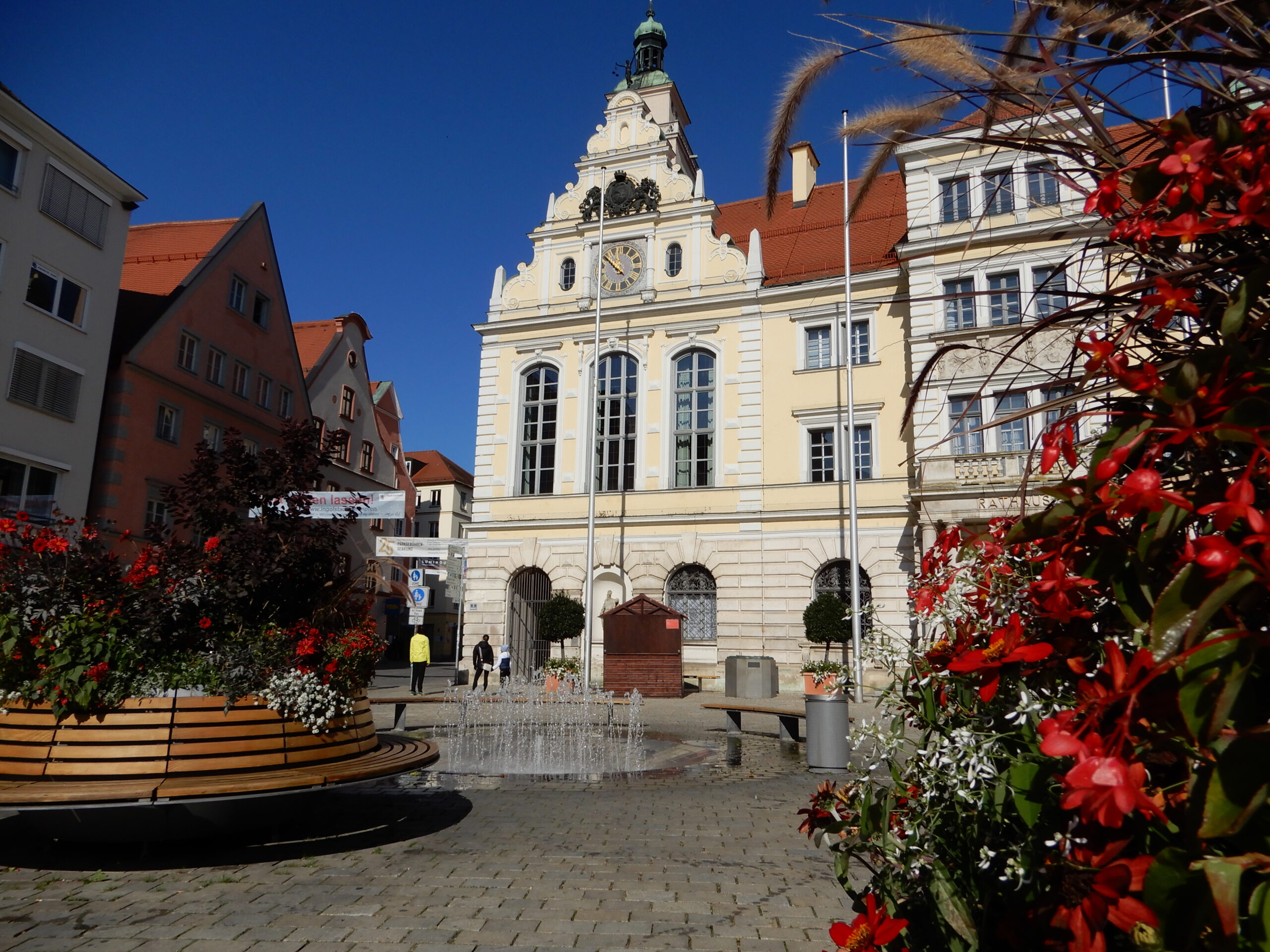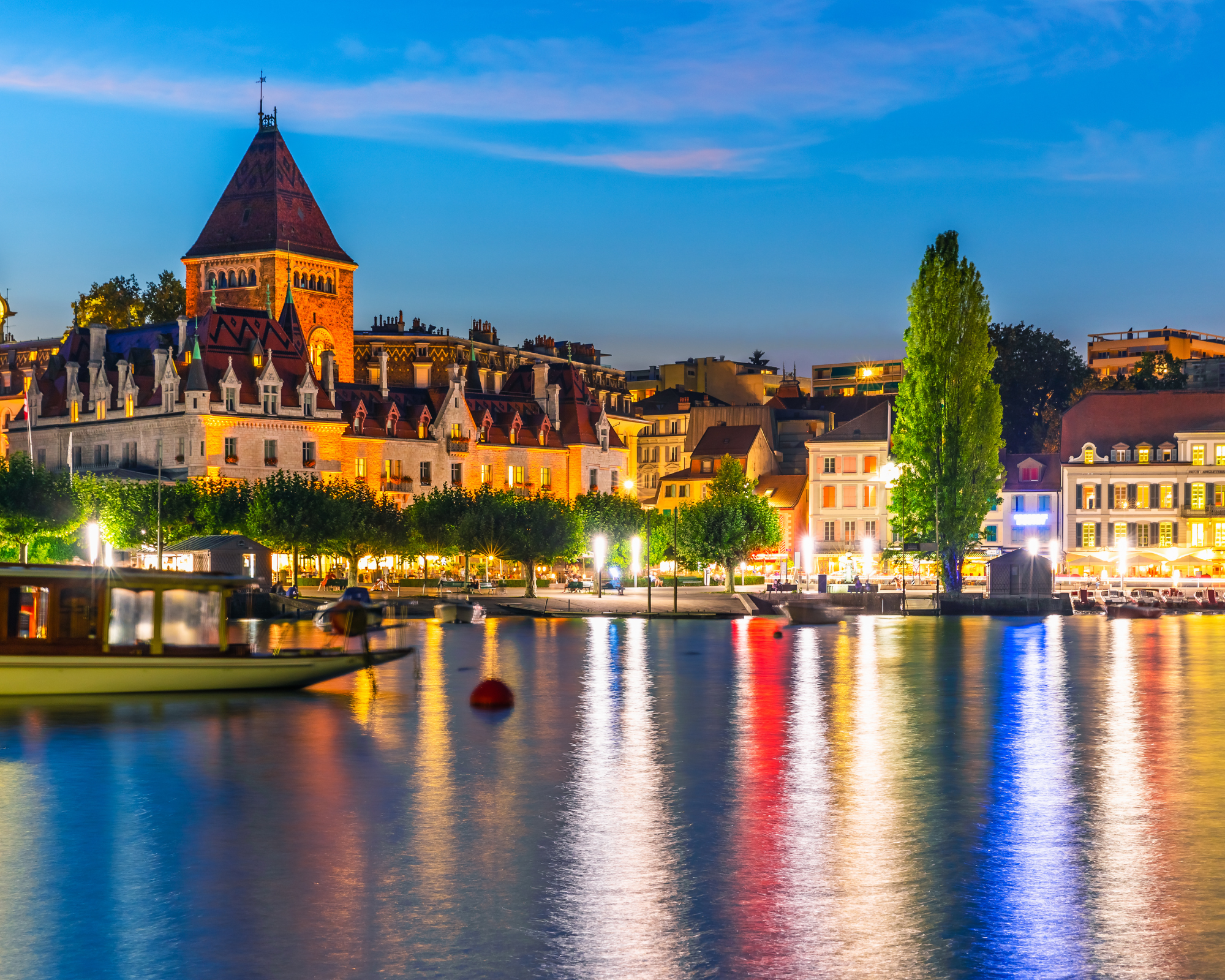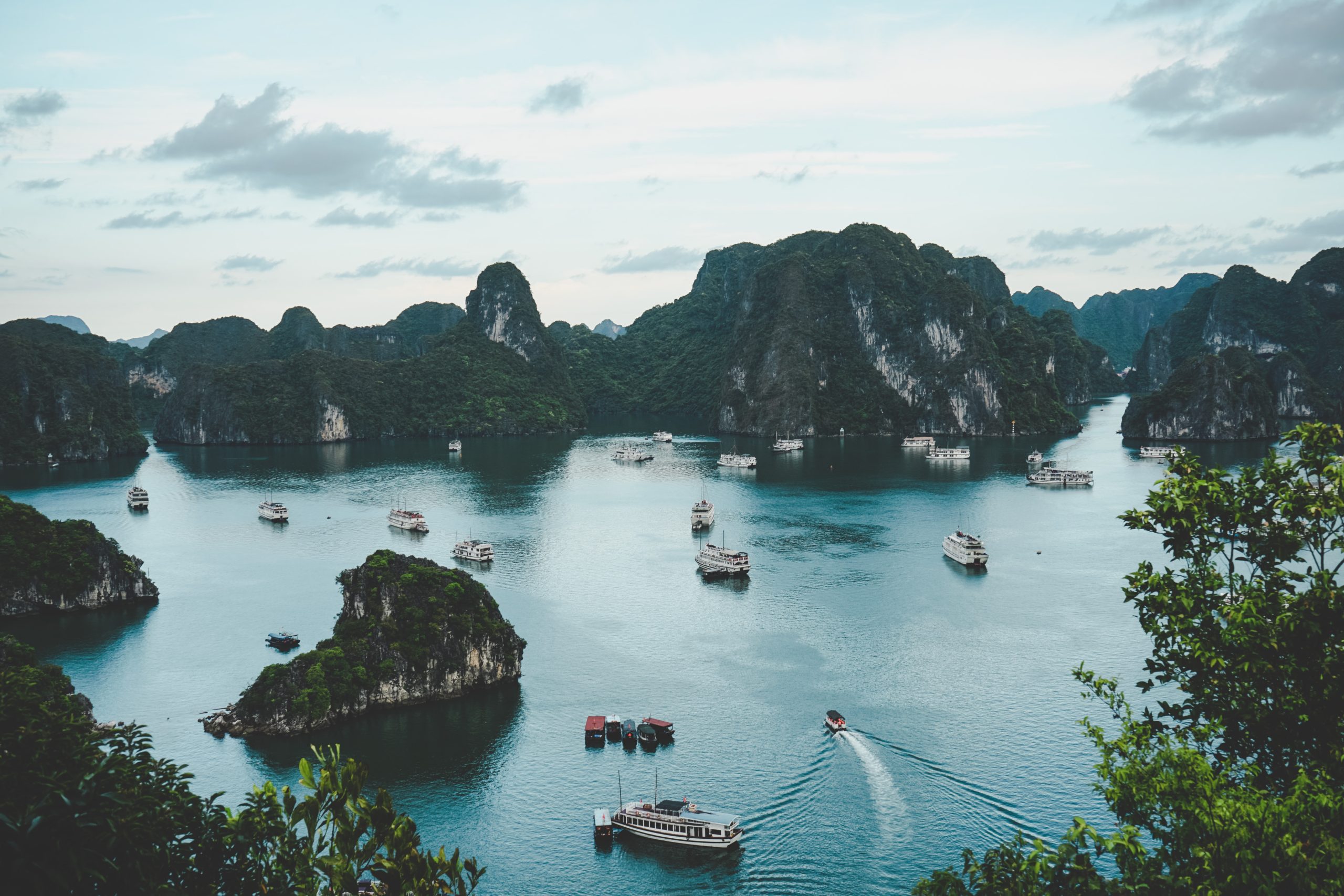
The Best Vietnam Restaurants and Top 18 places to visit
The Best Vietnam Restaurants and Top 18 places to visit
We have produced the greatest travel guide for those who enjoy exploring new destinations and having adventures. This page contains useful information about this incredible nation, including how to organize your trip ahead of time and where to discover flights, lodging, tours, restaurants in Vietnam, and even places to shop. Have fun reading our content!
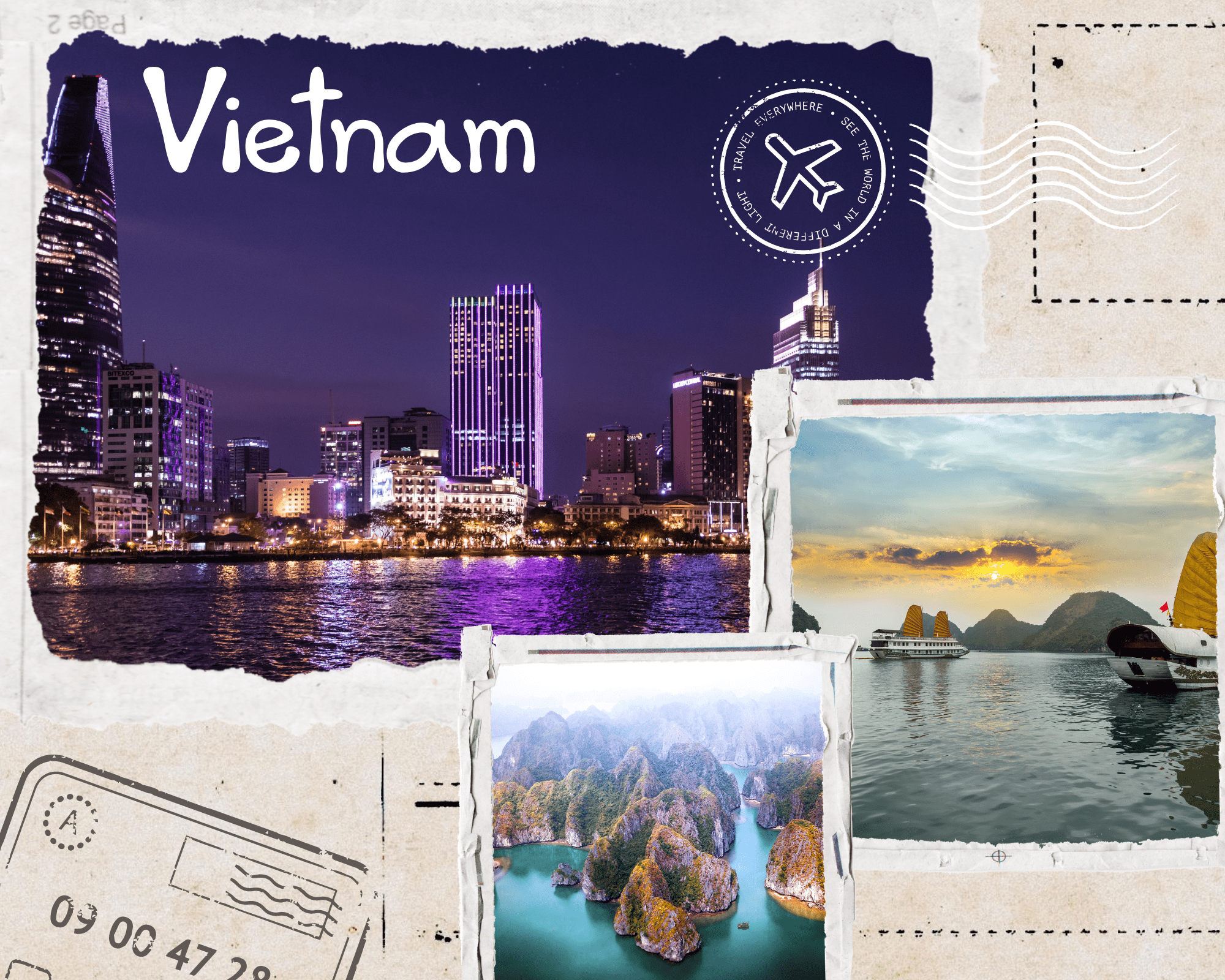
Photo Source : traveldreamdiary.com
Informations
Southeast Asian nation of Vietnam is the most eastern nation on the Indochinese Peninsula. With an anticipated 97.8 million people living there as of 2020, it ranks as the sixteenth most populated nation worldwide. Hanoi serves as the nation’s capital, and Ho Chi Minh City is the most populous city. Temperature: March through April in the spring and September through November in the fall are the ideal times to visit northern Vietnam because of the generally pleasant and bright days during these seasons.
Language: Vietnamese is the official language; English is increasingly favored as a second language. French, Chinese, Khmer and various highlander languages are also spoken.
Currency: Vietnamese Dong (VND) aprox. 1$ = 22,953 VND 1€=27,991 VND
Food Prices: Meal in a cheap restaurant=3 USD,Meal for 2 People, Mid-range Restaurant=20 USD
You can find more information about the visa here.
Notice: Several of the links below are affiliate links, which means that if you click over and make a purchase, I will get a commission at no extra cost to you. Here is a link to our complete affiliate disclosure.
Things to do
Tunnels of Cu Chi
The vast network of interconnected tunnels known as the Củ Chi tunnels (Vietnamese:Địa đạo Củ Chi) is situated in the Củ Chi District of Ho Chi Minh City (Saigon), Vietnam. It is a part of a much bigger network of tunnels that underpin a large portion of the nation.The Viet Cong used the Củ Chi tunnels as their base of operations for the 1968 Tết Offensive and as the site of other military operations throughout the Vietnam War. Ho Chi Minh City is home to the Củ Chi tunnels.Bến DượcBến DượcBến ĐìnhBến Đình The Củ Chi tunnels’ location in Ho Chi Minh City The tunnels served as housing quarters for many North Vietnamese combatants, hospitals, food and weapon stockpiles, communication and supply channels, and hiding places for Viet Cong members during battle.
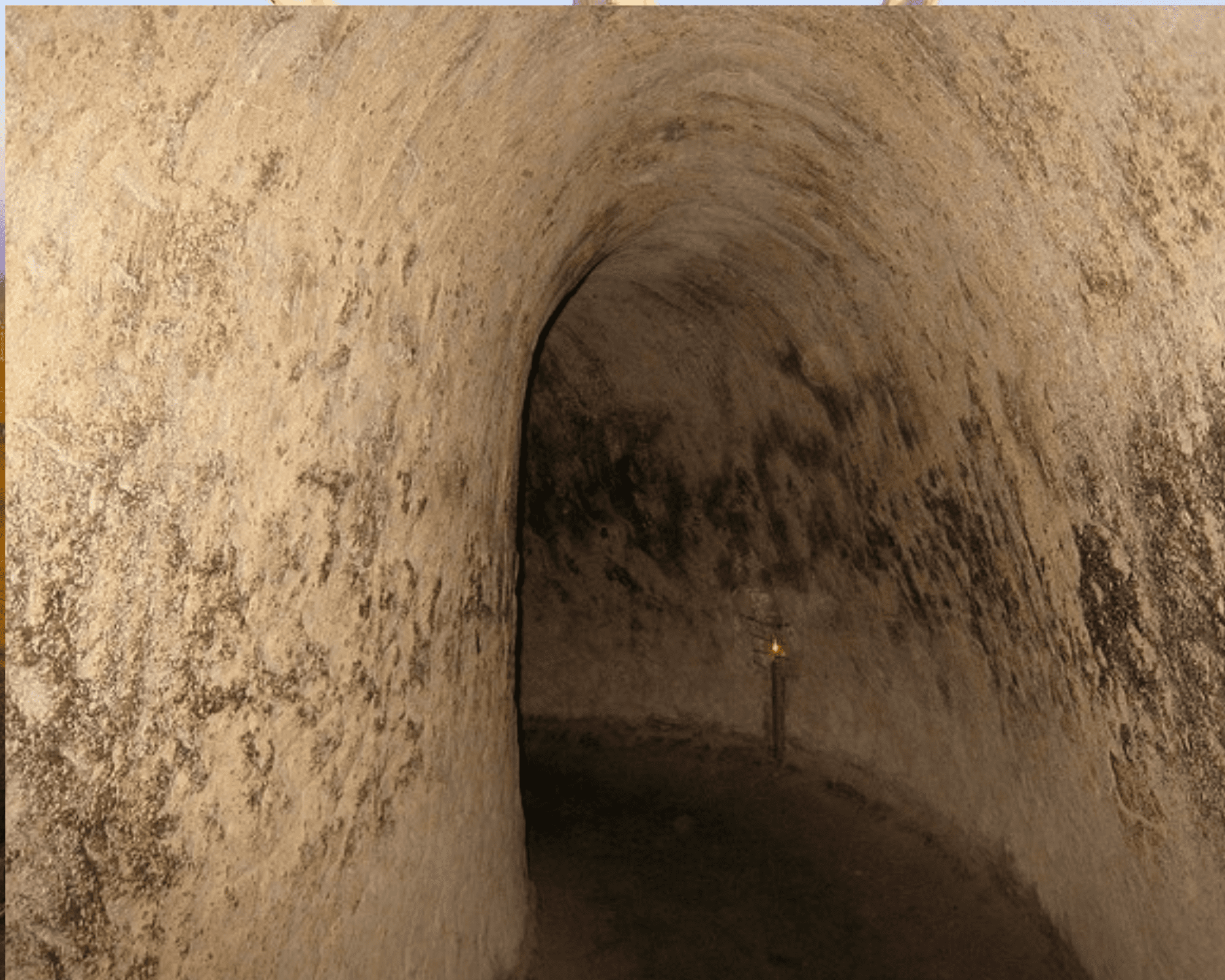
Photo Source : traveldreamdiary.com
Hoan Kiem Lake
Known as Sword Lake (Hồ Gươm) or Tả Vọng Lake (Hồ Tả Vọng), Hoàn Kiếm Lake (Vietnamese: Hồ Hoàn Kiếm, chữ Hán:,meaning “Lake of the Returned Sword” or “Lake of the Restored Sword”) is a freshwater lake that is around 12 hectares in the historical heart of Hanoi, the capital city of Vietnam. The lake was formerly known as “Thủy Quân Lake” (Vietnamese: Hồ Thủy Quân, meaning “Mariner’s Lake”) or “Lục Thủy Lake” (Vietnamese: Hồ Lục Thủy, meaning “Green Water Lake” – appropriately called for the hue of the water). One of the city’s most picturesque locations, the lake acts as a hub for public life.
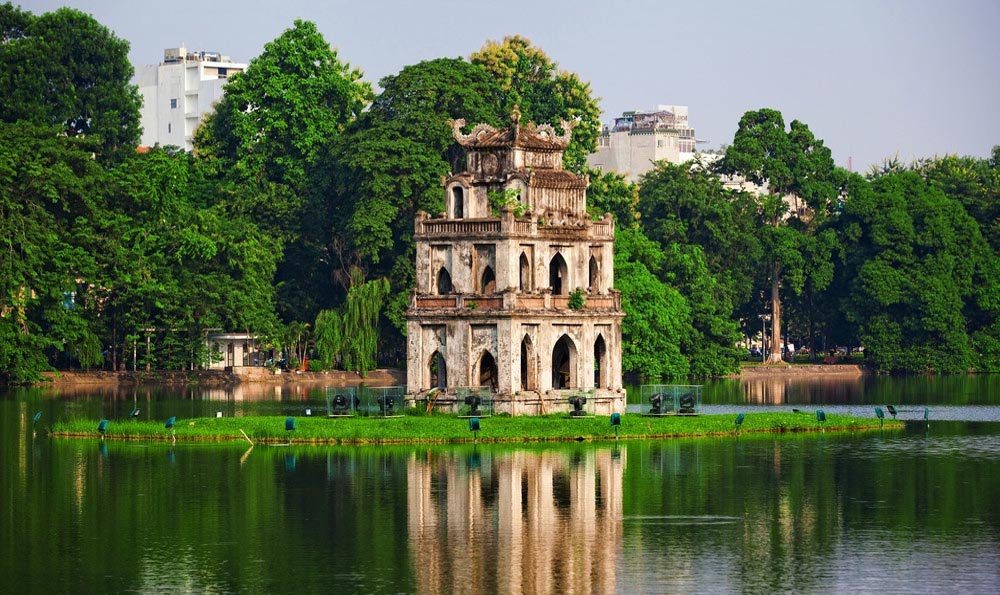
Photo Source : OanaAlexandra on Facebook
Cát Bà
The Cat Ba Archipelago, which forms the southeast boundary of Lan Ha Bay in Northern Vietnam and preserves the spectacular and untamed aspects of Ha Long Bay, is made up of 367 islands, the largest of which is Cát Bà Island, which spans 262.41 km2 (101.32 sq mi).The archipelago has been included in the Ha Long Bay-Cat Ba Archipelago World Heritage Site since 2023 and has been a UNESCO Biosphere Reserve since 2004.”Women’s Island” is what Cat Ba (formerly known as Cac Ba) Island signifies, with “Cac” standing for “all” and “Ba” for “women.”According to legend, three Tran Dynasty women were murdered many years ago, and their bodies drifted all the way to Cat Ba Island. Local fishermen discovered all three bodies after they washed up on separate beaches.
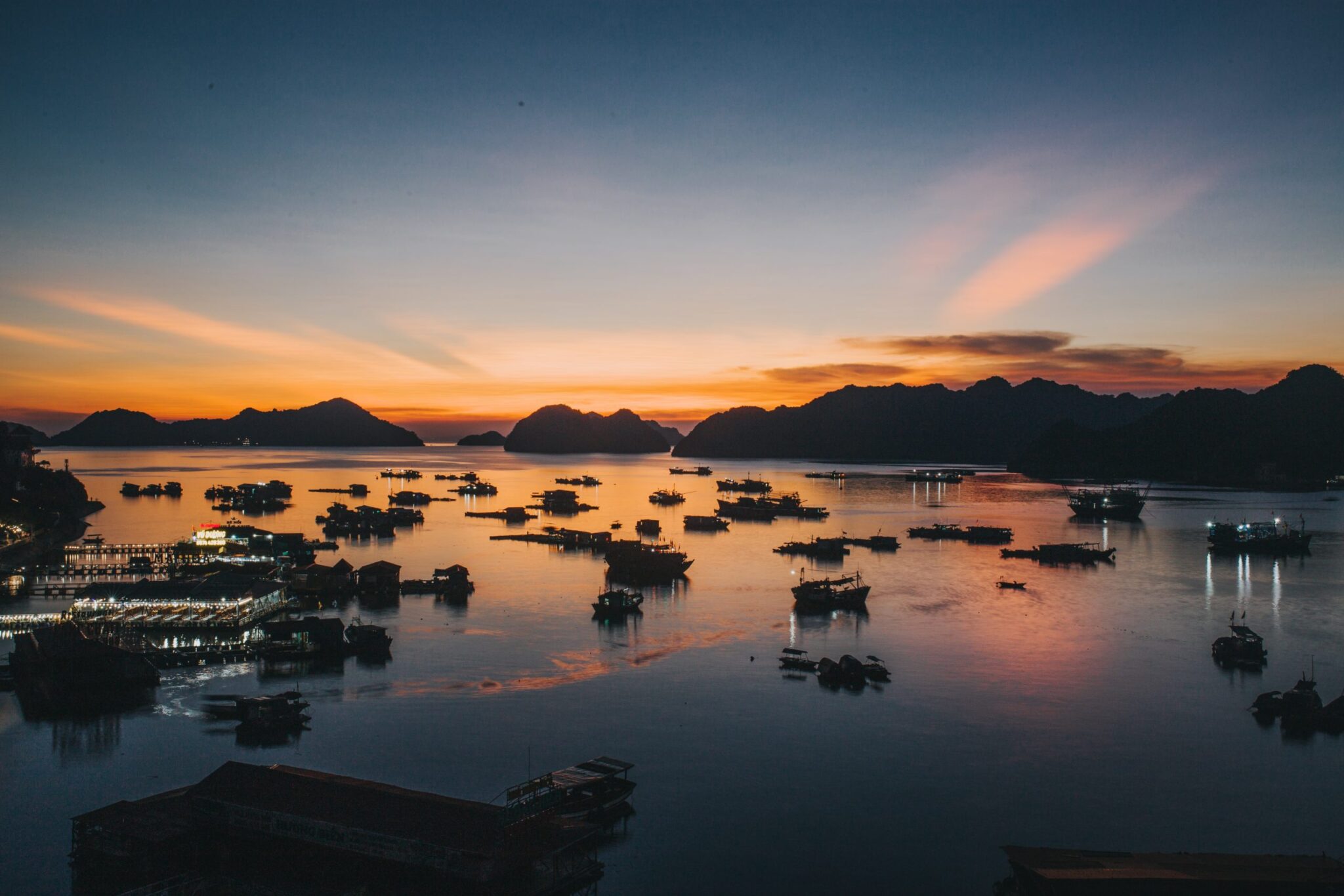
Photo Source : OanaAlexandra on canva.com
Mỹ Sơn
The Kings of Champa, an Indianized kingdom of the Cham people, built the collection of partially destroyed and deserted Shaiva Hindu temples in central Vietnam between the fourth and thirteenth centuries.According to Shaivism, the temples are devoted to the worship of God, who is known as Shiva, or The Auspicious One. He is worshipped in this complex under a number of regional names, the most significant being Bhadreshvara.In the administrative district of Duy Xuyên in Quảng Nam Province in Central Vietnam, Mỹ Sơn is situated next to the village of Duy Phú. It is roughly 10 kilometers from Trà Kiệu, the medieval Champa capital, and 69 kilometers southwest of Da Nang.
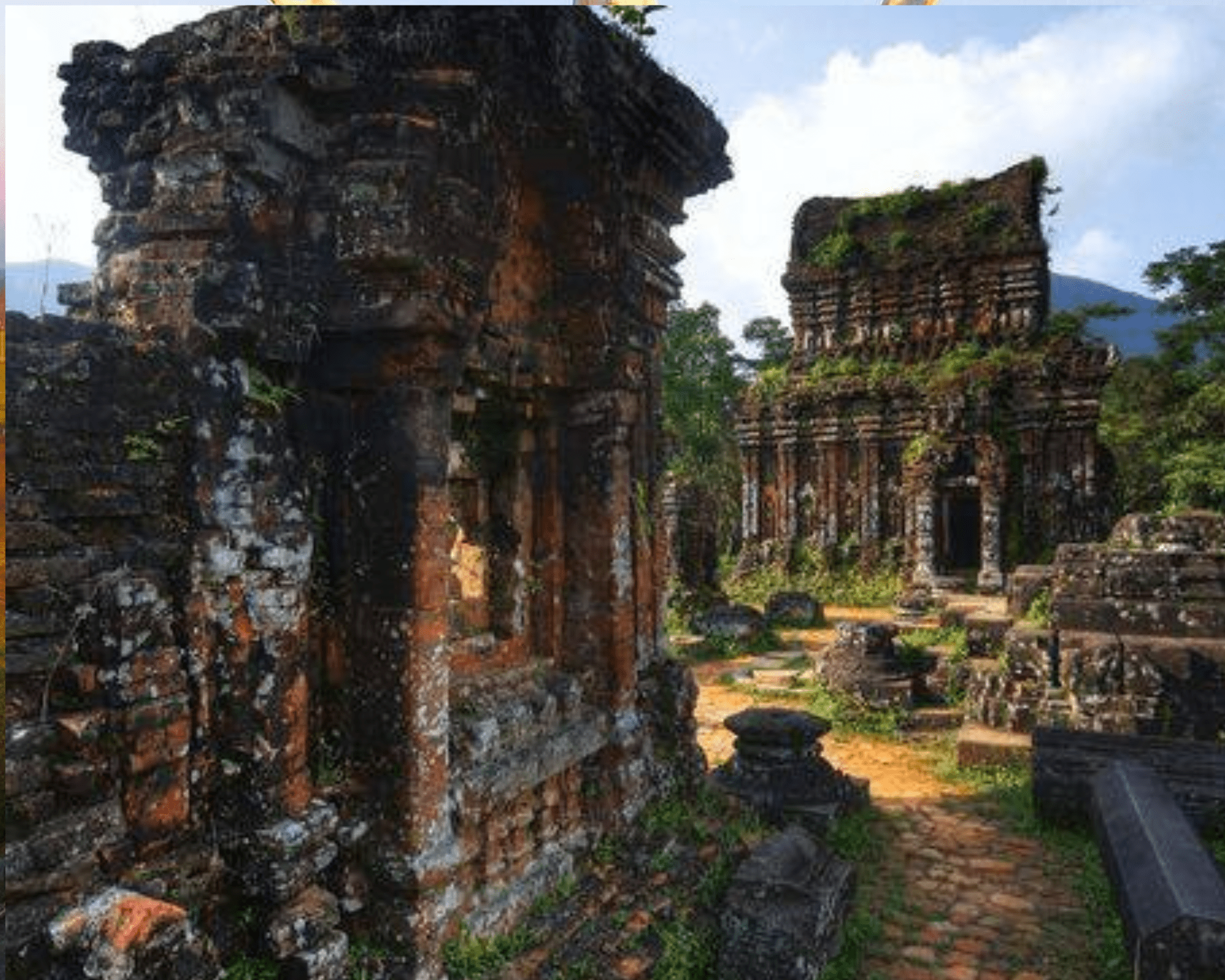
Photo Source : OanaAlexandra on canva.com
Ho Chi Minh-Mausoleum
The Kings of Champa, an Indianized kingdom of the Cham people, built the collection of partially destroyed and deserted Shaiva Hindu temples in central Vietnam between the fourth and thirteenth centuries.According to Shaivism, the temples are devoted to the worship of God, who is known as Shiva, or The Auspicious One. He is worshipped in this complex under a number of regional names, the most significant being Bhadreshvara.In the administrative district of Duy Xuyên in Quảng Nam Province in Central Vietnam, Mỹ Sơn is situated next to the village of Duy Phú. It is roughly 10 kilometers from Trà Kiệu, the medieval Champa capital, and 69 kilometers southwest of Da Nang.
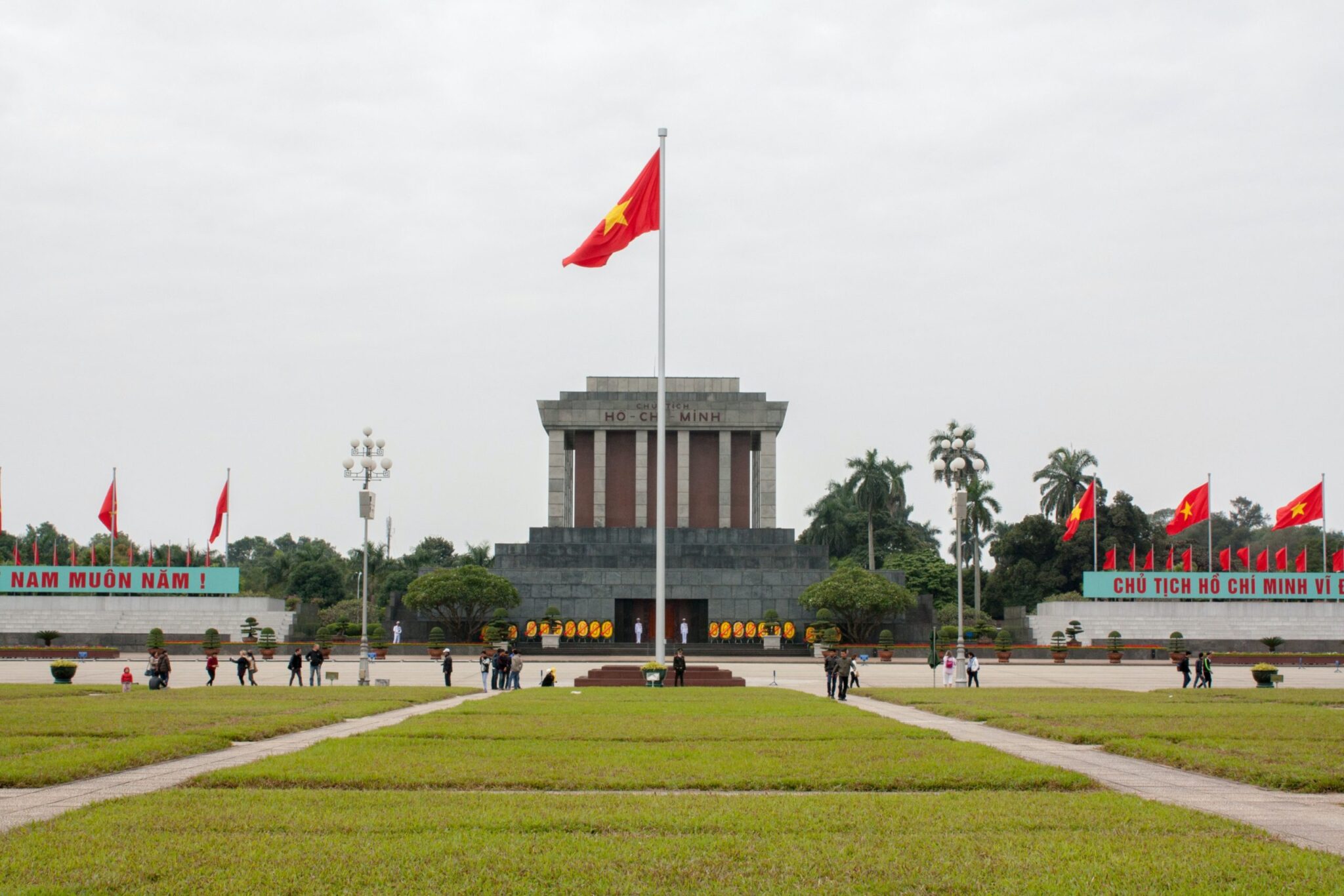
Photo Source : traveldreamdiary.com
The Marble Mountains
Five marble and limestone hills of the Ngũ Hành Sơn District, south of Da Nang city, Vietnam, are known as the Marble Mountains (Vietnamese: Ngũ Hành Sơn, Chữ Hán.”five elements mountains”). Kim (metal), Thủy (water), Mộc (wood), Hỏa (fire), and Thổ (earth) are the names of the five mountains. There are several tunnels and cave entrances in each mountain, and Mount Thủy’s summit is reachable by climbing. The highlands are home to a number of Buddhist sanctuaries, which attract tourists. Crafts involving stone cutting and carving are well-known in the region. Recently, direct rock extraction from the mountains was outlawed. Quảng Nam Province quarries are currently shipping materials.
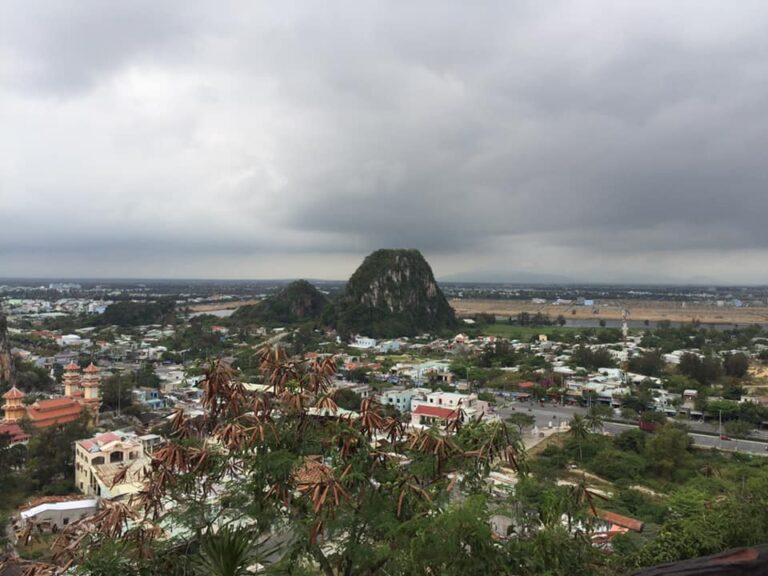
Photo Source : OanaAlexandra on Facebook
Temple of Literature
In Hanoi, northern Vietnam, there is a temple devoted to Confucius called Văn Miếu (Vietnamese: Văn Miếu, chữ Hán), which translates literally as Temple of Literature. However, the name should actually read Temple of Confucius, since Văn alludes to Confucius. Founded and initially constructed during the reign of Emperor Lý Thánh Tông in 1070, the temple served as the home of Vietnam’s first national institution, the Imperial Academy (Quốc Tử Giám, 國子監), from 1076 to 1779.One of the many temples in Vietnam devoted to Confucius, sages, and intellectuals is the Văn Miếu. The temple is situated south of Thăng Long’s Imperial Citadel.
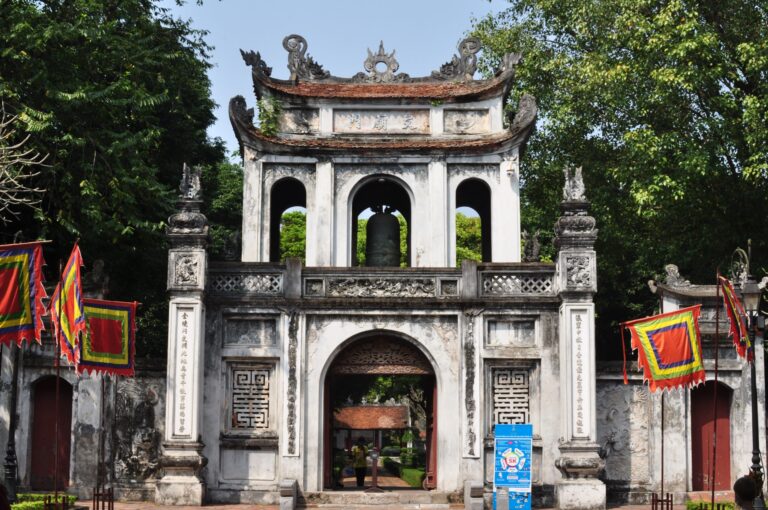
Photo Source : traveldreamdiary.com
The Ben Thanh Market
District 1 of Hồ Chí Minh City, Vietnam, is home to Bến Thành Market (Vietnamese: Chợ Bến Thành).The market is a significant landmark and one of the oldest buildings still standing in Ho Chi Minh City. Ben Thanh Market is a well-known travel attraction for both domestic and international travelers.The market is open year-round, starting at about 6 a.m. and officially ending at 6 p.m.The day market turns into a night market at 6 p.m. and lasts until 10 p.m.Over 10,000 people attend and shop at Ben Thanh Market every day these days.More than 6,000 small enterprises with roughly 1,500 booths at the market sell everything from luxury goods to staples at wholesale and retail prices.
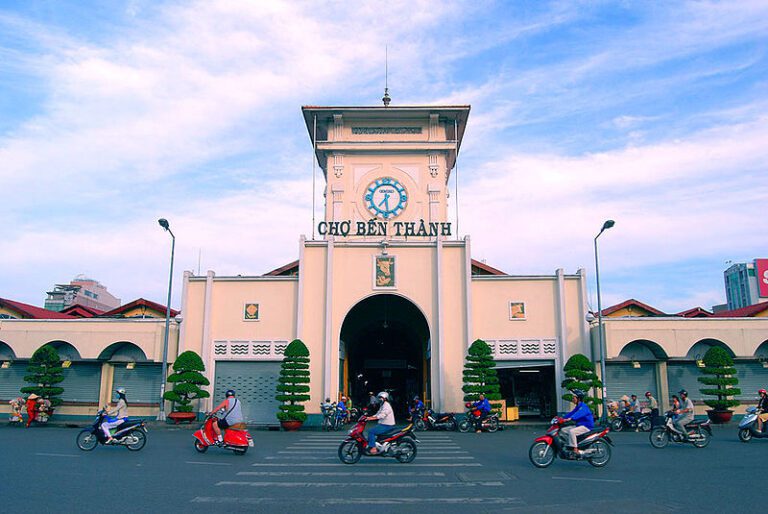
Photo Source : traveldreamdiary.com
Ba Na Hills Đà Nẵng
Located in the Bà Nà Hills resort, close to Da Nang, Vietnam, the Golden Bridge (Vietnamese: Cầu Vàng) is a pedestrian bridge that is 150 meters (490 feet) long.In addition to offering a picturesque view and a tourist attraction, it is intended to link the cable car station and the gardens without creating a high gradient . The bridge has two enormous hands that support the structure and loop almost back around to itself. They are made of fiberglass and wire mesh and are meant to resemble stone hands. The Sun Group was the project’s client.Ho Chi Minh City-based TA Landscape Architecture, a division of Ho Chi Minh City University of Architecture, created the bridge.
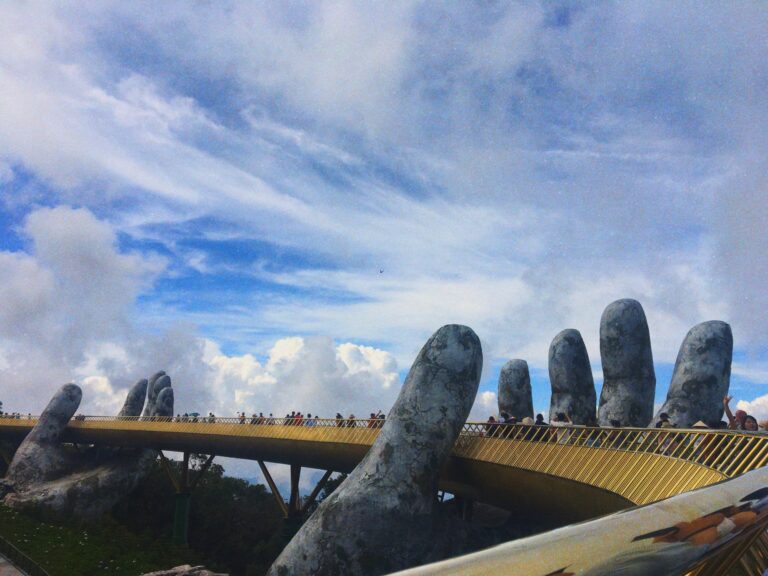
Photo Source : OanaAlexandra on canva.com
Bản Giốc Detian waterfalls
After the Iguazú, Victoria, and Niagara Falls, the Bản Giốc Detian Waterfalls rank fourth among the world’s greatest waterfalls. Of them, half are in the Daxin County of Chongzuo City and the other half are in the Cao Bằng Province in Vietnam.There, across a height differential of roughly 53 meters, the river Quy Xuân, which is a part of the west river’s catchment area, runs in a multi-stage cascade that is 300 meters wide. May through September are the months when the river has the most water in it.
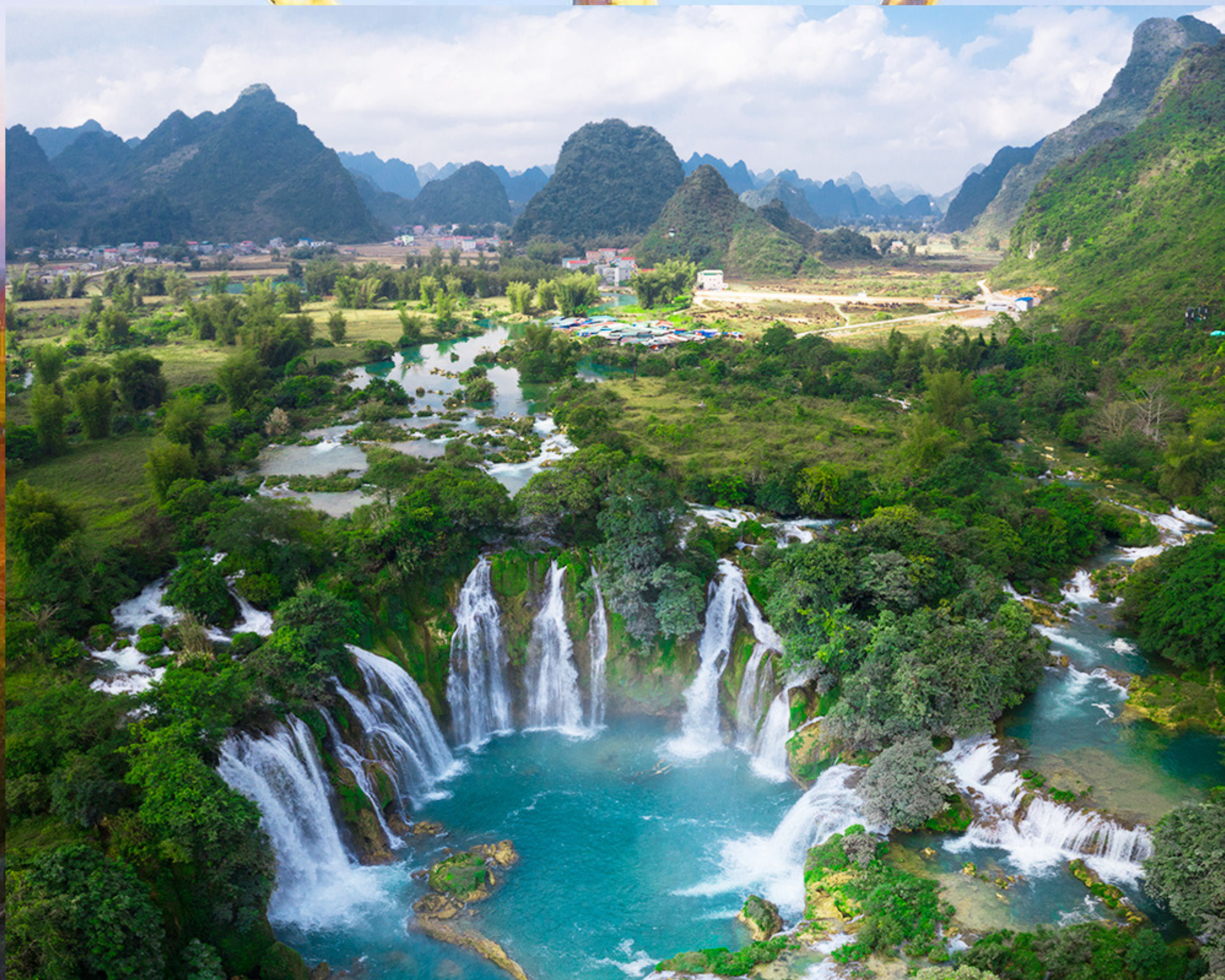
Photo Source : Welcome to Vietnam on Facebook
Notre-Dame Cathedral of Saigon
In Ho Chi Minh City, Vietnam, there is a Roman Catholic church in the neo-Romanesque style called the Notre-Dame Cathedral of Saigon, also known as the Cathedral Basilica of the Immaculate Conception (Vietnamese: Nhà Thờ Chính Tòa Đức Mẹ Vô Nhiễm Nguyên Tội). The Immaculate Conception is the patroness of the cathedral of the Archdiocese of Ho Chi Minh City, which is designated as a minor basilica.The church was constructed to house religious services for the French colonialists in what is now Ho Chi Minh City, formerly Saigon. The cathedral replaced the old wooden church, which was much too tiny and severely termite-damaged, on October 7, 1877, when Isidor Colombert, the Apostolic Vicar of West Cochin, set the foundation stone. After three years of construction, the structure was officially opened with a ceremony on Easter Monday, April 11, 1880. at 1965, the current archdiocese was formed from the Apostolic Vicariate of West Cochin, which was headquartered at the church. Pope John XXIII granted the church the status of minor basilica as early as 1962.
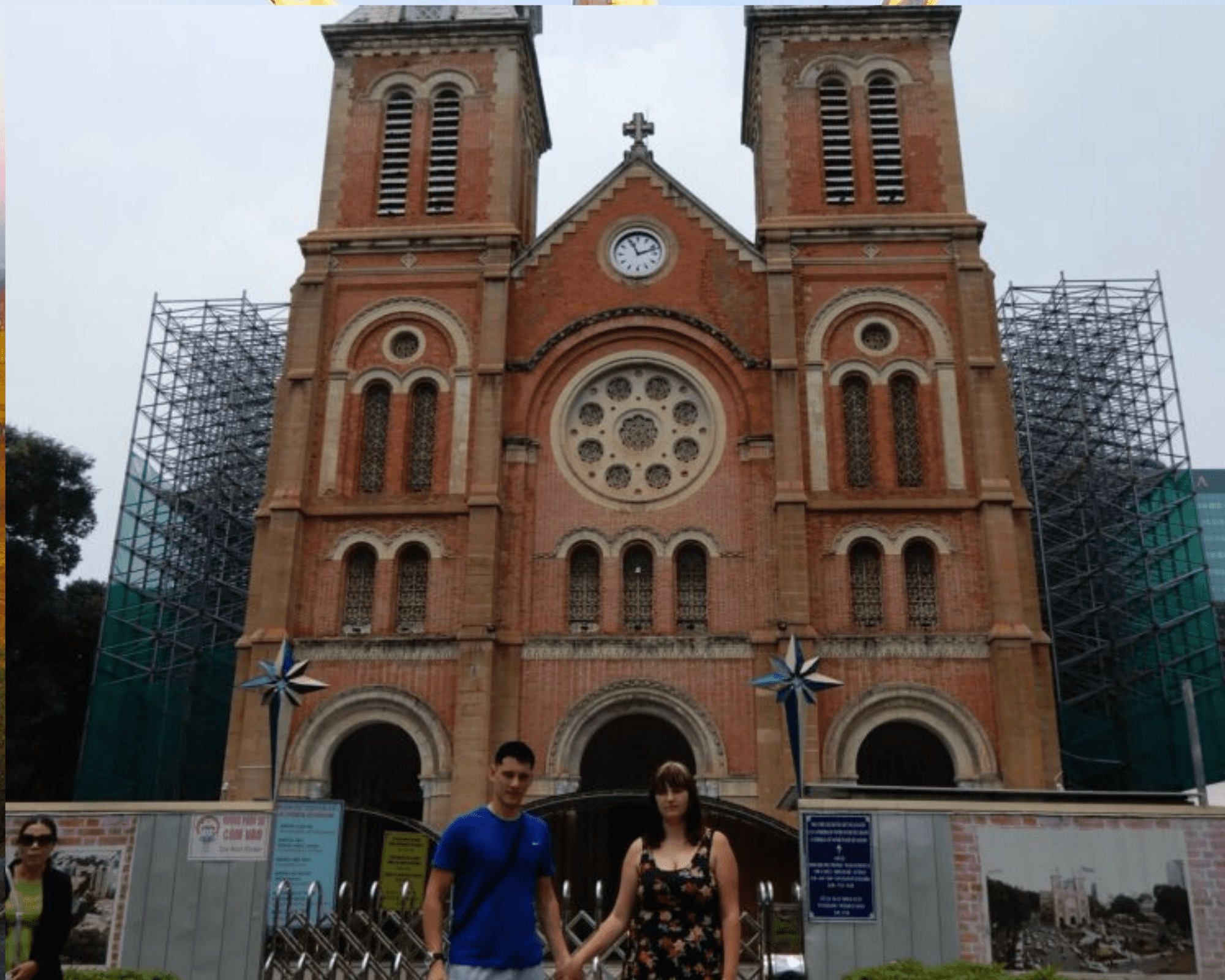
Photo Source : traveldreamdiary.com
West Lake
Northwest of the city center sits Hanoi, Vietnam’s largest freshwater lake, West Lake (Vietnamese: Hồ Tây). With 500 hectares (5.0 km2) and a beach length of 17 kilometers (11 mi), this is the capital’s largest lake and a well-liked recreational area with lots of surrounding gardens, hotels, and houses. Trúc Bạch Lake is created when Thanh Niên Road splits a small portion of West Lake. The majority of the lake is situated in the lake-named Tây Hồ District.Several Vietnamese stories mention West Lake, which was formed from a curved section of the Red River. According to one tale, West Lake was previously known as “Fox Corpse Swamp” (Đầm Xác Cáo) since it was formed as a result of the conflict between Lạc Long Quân and a hồ tinh (nine-tailed fox). According to another folktale, the lake was formerly known as “Golden Buffalo Lake” (Hồ Trâu Vàng, or Sino-Vietnamese vocabulary:
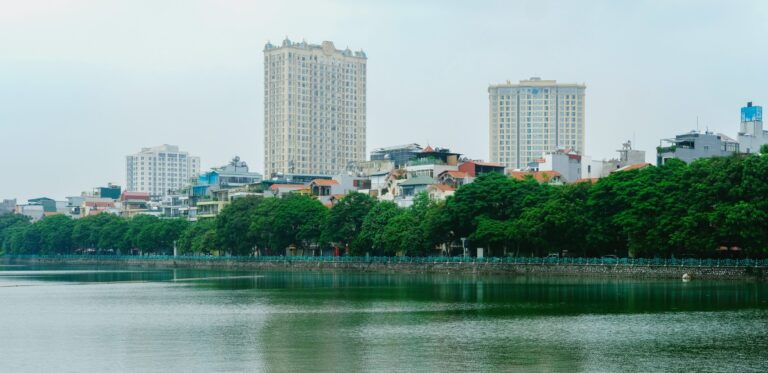
Photo Source : OanaAlexandra on canva.com
The crazy house
Vietnamese architect Đặng Việt Nga developed and built the unusual Hằng Nga guesthouse (Vietnamese: Biệt thự Hằng Nga), also referred to as the “Crazy House” (Vietnamese: Ngôi nhà quái dị), in Đà Lạt, Vietnam. Hằng Nga, chữ Hán: 姮娥, is the Chinese goddess of the Moon, and the building is described as a “fairy tale house.” Its general design is reminiscent of a huge tree, with sculptured components that depict natural forms like animals, mushrooms, spider webs, and caves. Expressionist has been used to define its architecture, which consists of intricate, organic, non-rectilinear shapes. Nga has said that the building’s design was influenced by Catalan architect Antoni Gaudí, and guests have made different comparisons between it and the creations of Walt Disney and Salvador Dalí.
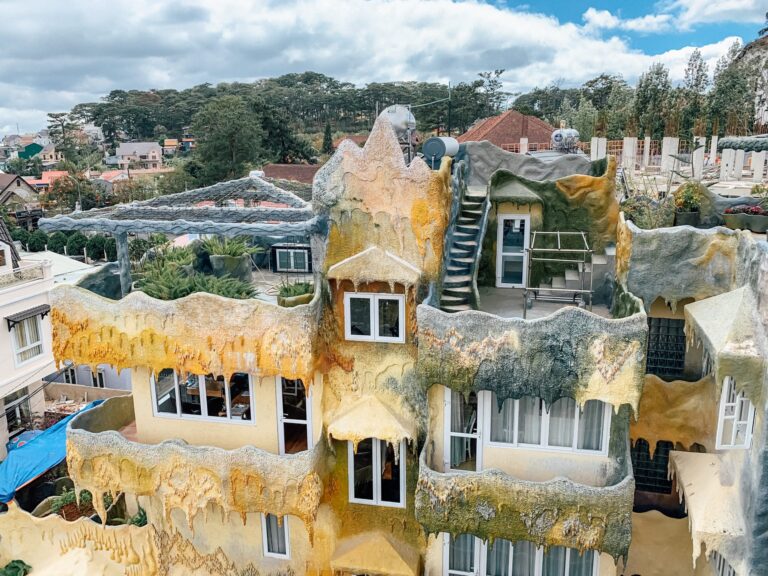
Photo Source : traveldreamdiary.com
Bitexco Financial Tower
In Ho Chi Minh City, Vietnam’s District 1, there is a skyscraper called the Bitexco Financial Tower. When it was finished in 2010 at a height of 265.5 m, it was the highest building in Vietnam. A movie theater and a freely accessible shopping mall are located on the first four stories. On the ground floor are the Skydeck elevators as well. The first floor houses the restaurant and café elevators. Every day from 9:30 a.m. to 9:30 p.m., Saigon Skydeck observation deck is open for visitors for VND 200,000. There is some free entry to the restaurant, bar, and café. The 52nd floor platform doubles as a helipad.
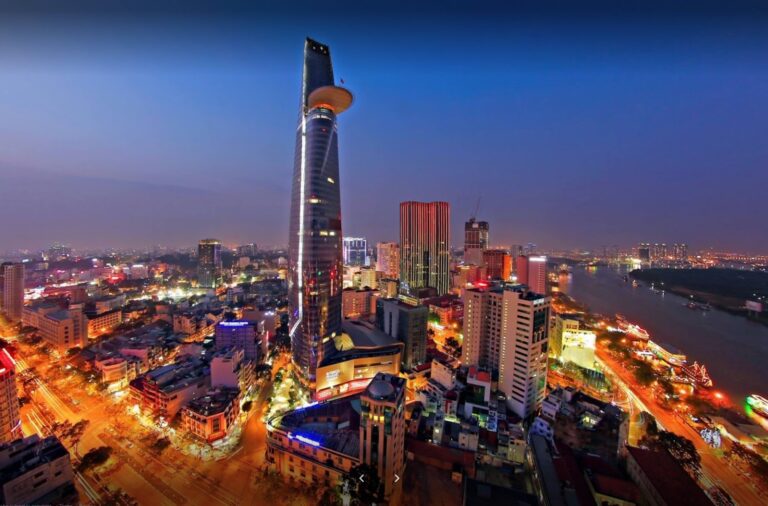
Photo Source : traveldreamdiary.com
Tran Quoc-Pagode
The Trấn Quốc Pagoda in Hanoi is the oldest pagoda in the city. It was built in the sixth century, more than 1,500 years ago, during Emperor Lý Nam Đế’s reign (from 544 to 548). The temple was established on the banks of the Red River, beyond the Yen Phu Dyke, and was given the name Khai Quoc (National Founding). When the river began to intrude, the temple was moved in 1615 to its current location on the Kim Ngu (Golden Fish) islet of Ho Tay (West Lake). It connects to the mainland via a tiny causeway. 1815 saw the completion of the temple’s final significant repairs to the main sanctuary, reception hall, and posterior chamber of the dead.
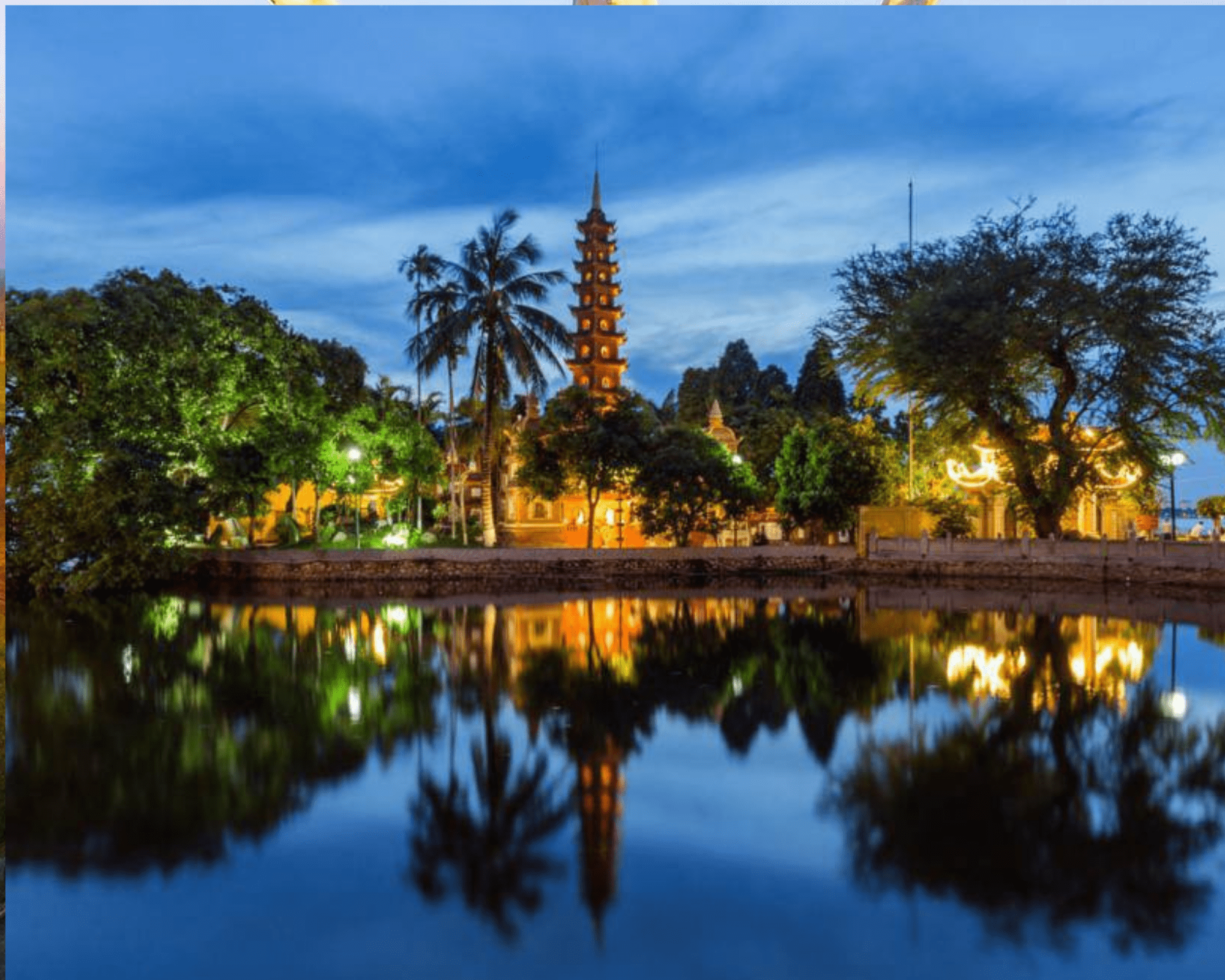
Photo Source : Easyvoyage on Facebook
St. Joseph Cathedral
Vietnam’s Catholic metropolitan archdiocese is called the Metropolitan Archdiocese of Hanoi (Latin: Archidioecesis Metropolitae Hanoiensis; Vietnamese: Tổng giáo phận đô thành Hà Nội; French: Archidiocèse Metropolitain d’Hanoï). It is among the oldest in the Vietnamese Catholic Church’s history. On November 24, 1960, the diocese’s current shape was officially established. Since November 2018, Archbishop Joseph Vũ Văn Thiên has presided over the 7,000 km2 facility.The archdiocese has designated Saint Joseph Cathedral in Hanoi as its cathedral.The neo-Gothic cathedral was constructed in 1886. It is typically packed on weekends and holy festivals and hosts multiple masses throughout the day. Over 4,000 people visited the church during the 2004 Christmas break.
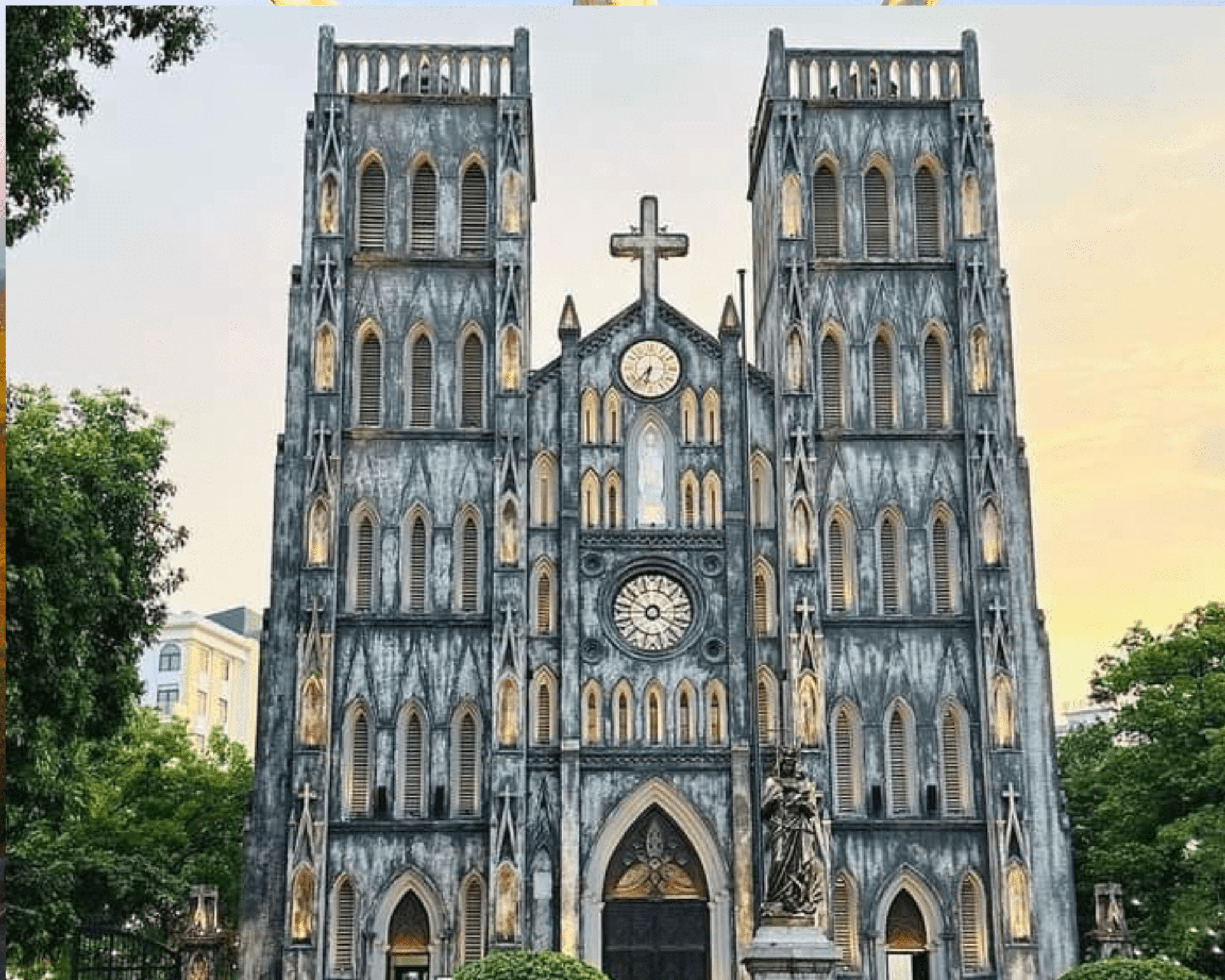
Photo Source : Melody Bolanos on Facebook
Linh Phuoc Pagoda
Also called Ve Chai Temple, Linh Phước Temple (Vietnamese: Chùa Linh Phước, Chữ Hán:IPA:) is situated on Highway 20 at No. 120 Tu Phuoc, Trai Mat District, Vietnam, 8 kilometers from Da Lat city center. The head of the 49-meter-long dragon temple, which is constructed out of 12,000 bottles, is 7 meters high.One of Da Lat City’s unique architectural mosaics is Linh Phuoc Pagoda. The temple’s construction was finished in 1952, having begun in 1949. Ven. Thich Tam Vi renovated the temple and constructed additional structures in 1990.Two rows of cobblestone mosaics adorn the main hall, which is 33 meters long and 12 meters broad. Numerous mosaic bas-reliefs depicting Shakyamuni’s and the Lotus Sutras’ histories are affixed to it.
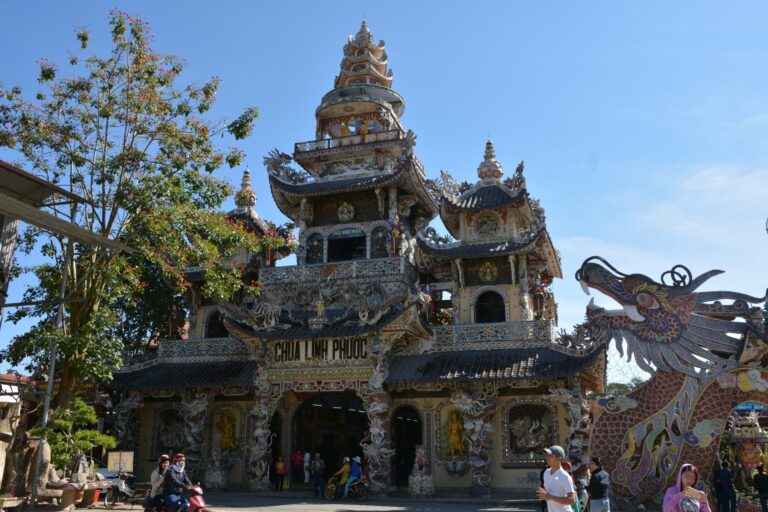
Photo Source : OanaAlexandra on canva.com
Tượng Phật Bà Quan Âm
Located in Chùa Việt Nam in Sugar Land, Texas, just outside of Houston, stands the Sugar Land Quan Âm, a cast concrete statue. The sculpture shows the female bodhisattva Avalokitesvara perched atop a lotus pedestal. Another common name for her could be Guanyin in Chinese.
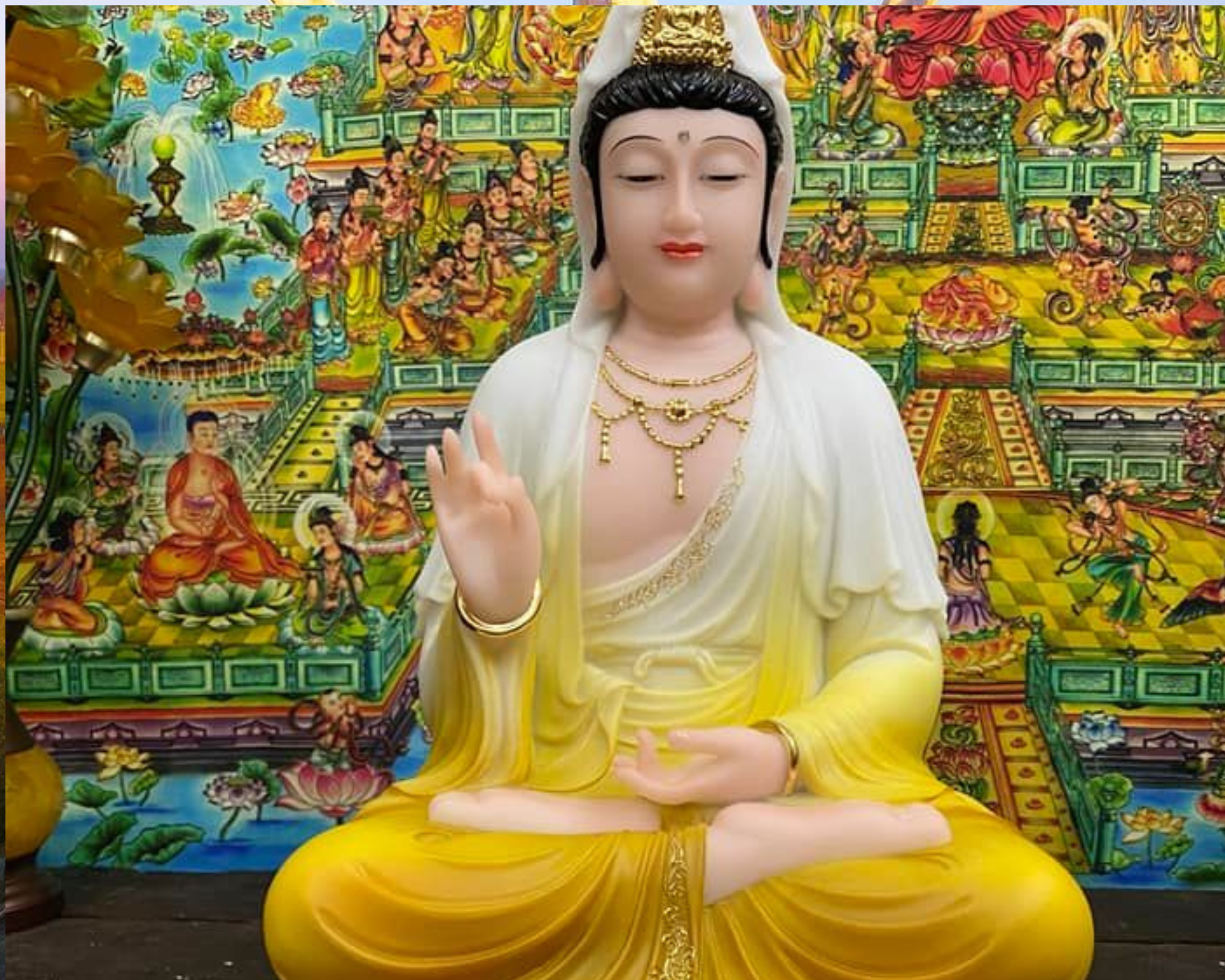
Photo Source : Oana Alexandra on Facebook
Book your perfect vacation!
Vacations: We are happy that we have the opportunity to work with the most famous companies in the world, we always order our vacations from these companies and we have never been disappointed: Check 24, Trivago, Trafalgar, TravelUp, Insight Vacations, Explorer Fernreisen.
Where to stay
Hotels, bed & breakfasts, and guesthouses, regardless of location—in the center of town, close to a lake, or amid natural surroundings. We were able to identify the top companies providing the best hotels: Booking.com, Trip.com, TravelUp, esky, Hoteltopia, Millennium Hotels and Explorer Fernreisen.
Traditional Food
Pho is a dish that consists of fresh rice noodles, a flavorful broth, chicken or beef, and a sprinkle of herbs. An excellent banh xeo comprises of a crunchy crepe brimming with pork, shrimp, and bean sprouts, accompanied by a garnish of fresh herbs. Pork noodle soup, or cao lau Crunchy spring rolls, or nem ran/cha gio When you’re craving some oily pub grub, Vietnamese fare like bo bit tet, which is similar to steak and eggs, hits the spot. Typically, the thin flank steak is served sizzling on a cast iron dish with eggs, thick potato wedges, and Vietnamese meatballs.
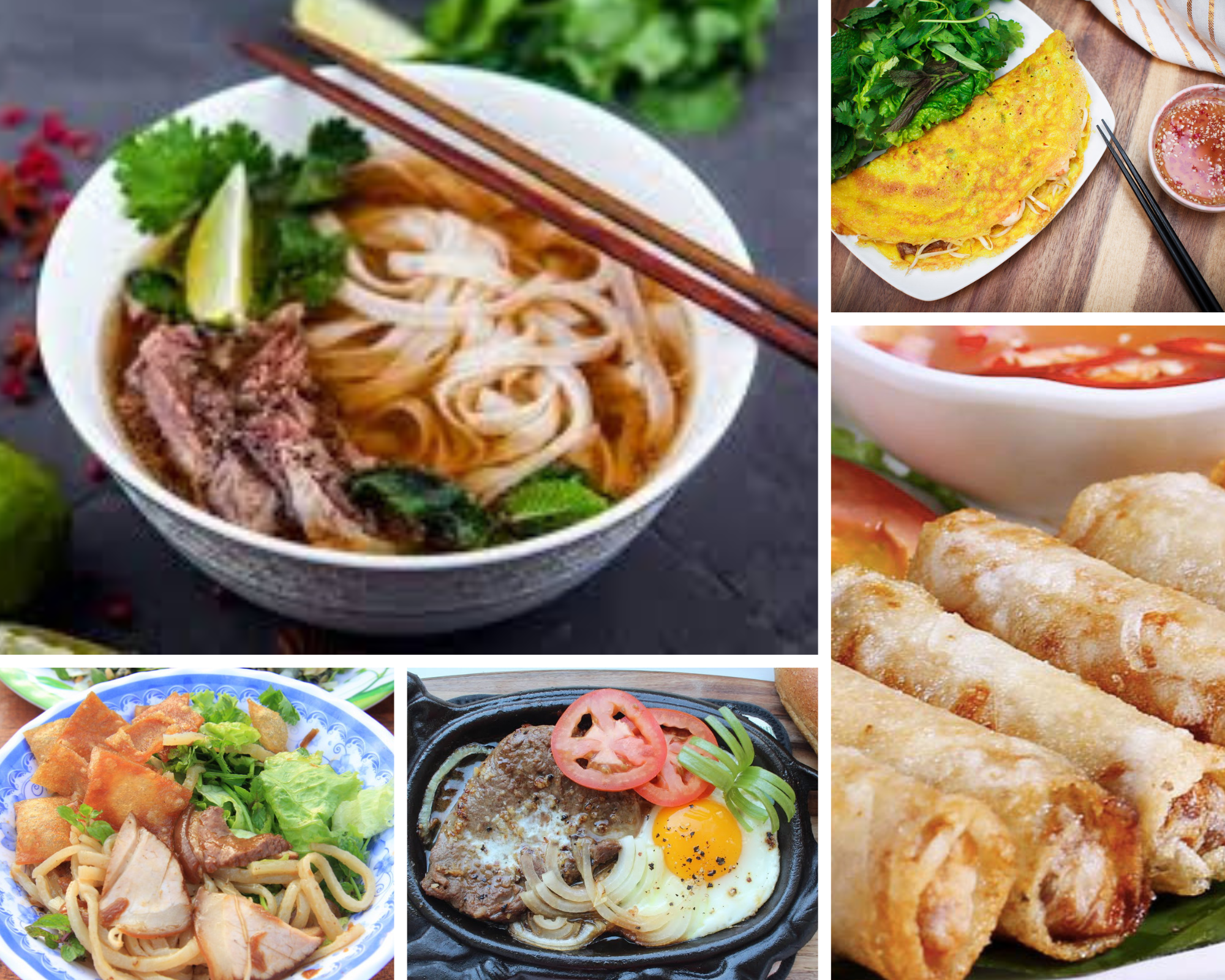
Photo Source : traveldreamdiary.com
Ca tim kho: Diced eggplant, sugar, soy sauce, minced pork, and tomatoes are sautéed in a clay pot. Saigon’s favorite street food is bot chien. In a big pan, fry dough made with rice flour chunks until crispy, then crack an egg into the mixture. After cooking, it is served with rice vinegar, chili sauce, shallots, and green onions. Mam tom sauce is served with the tofu and noodle dish bun dau mam tom. Popular throughout Central Vietnam is banh uot thit nuong, which is grilled pork wrapped in fresh rice paper rolls. Chicken noodle soup, or ga tan
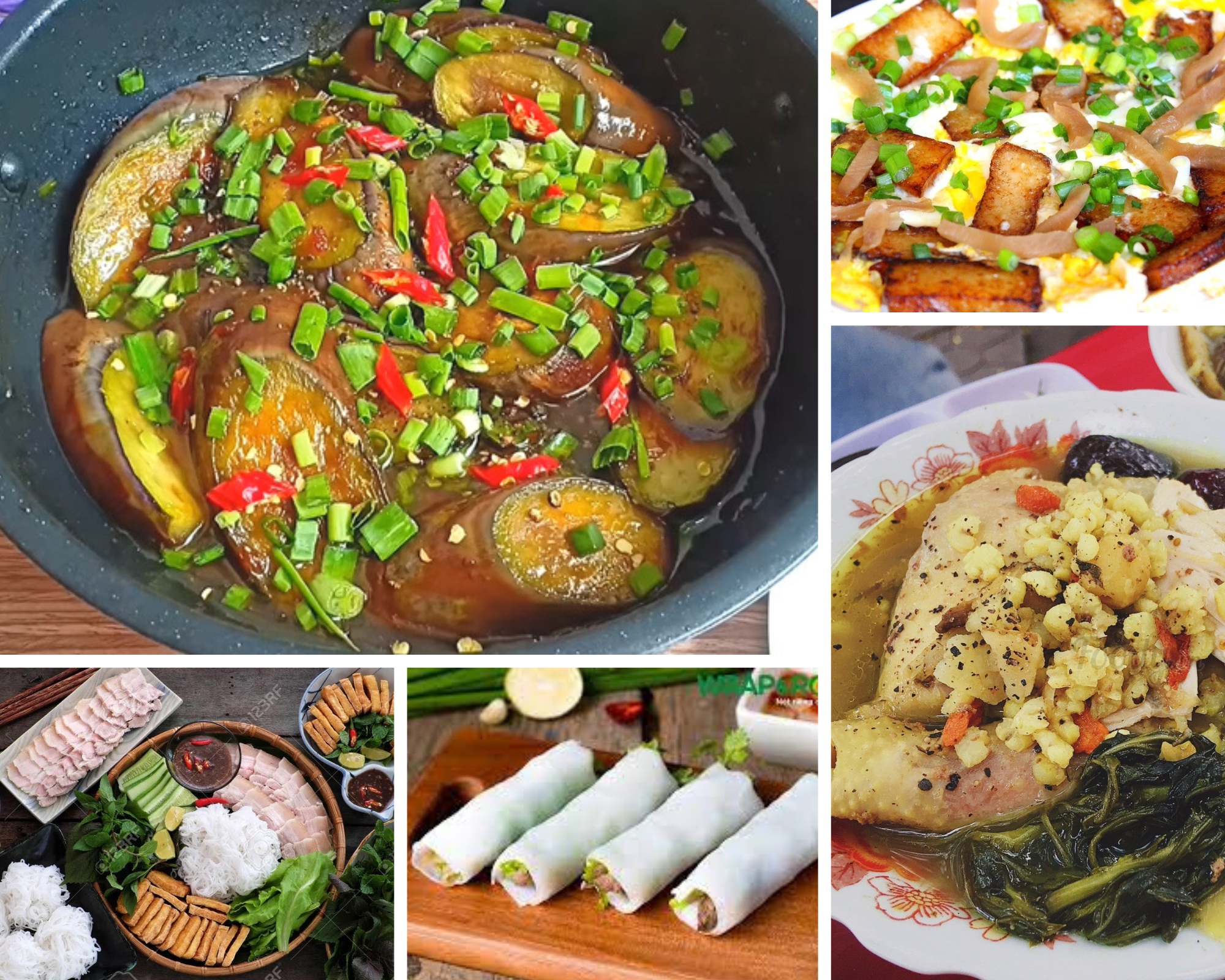
Photo Source : traveldreamdiary.com
Layers of bean jelly, coconut milk, fruit, and ice are evident in Che. Banh Tieu Hoa Quả Dầm, a Vietnamese doughnut, is made with shaved ice, coconut cream, and fresh mixed fruit. Kem Xôi is a sticky rice dish with coconut ice cream and green pandan flavor.
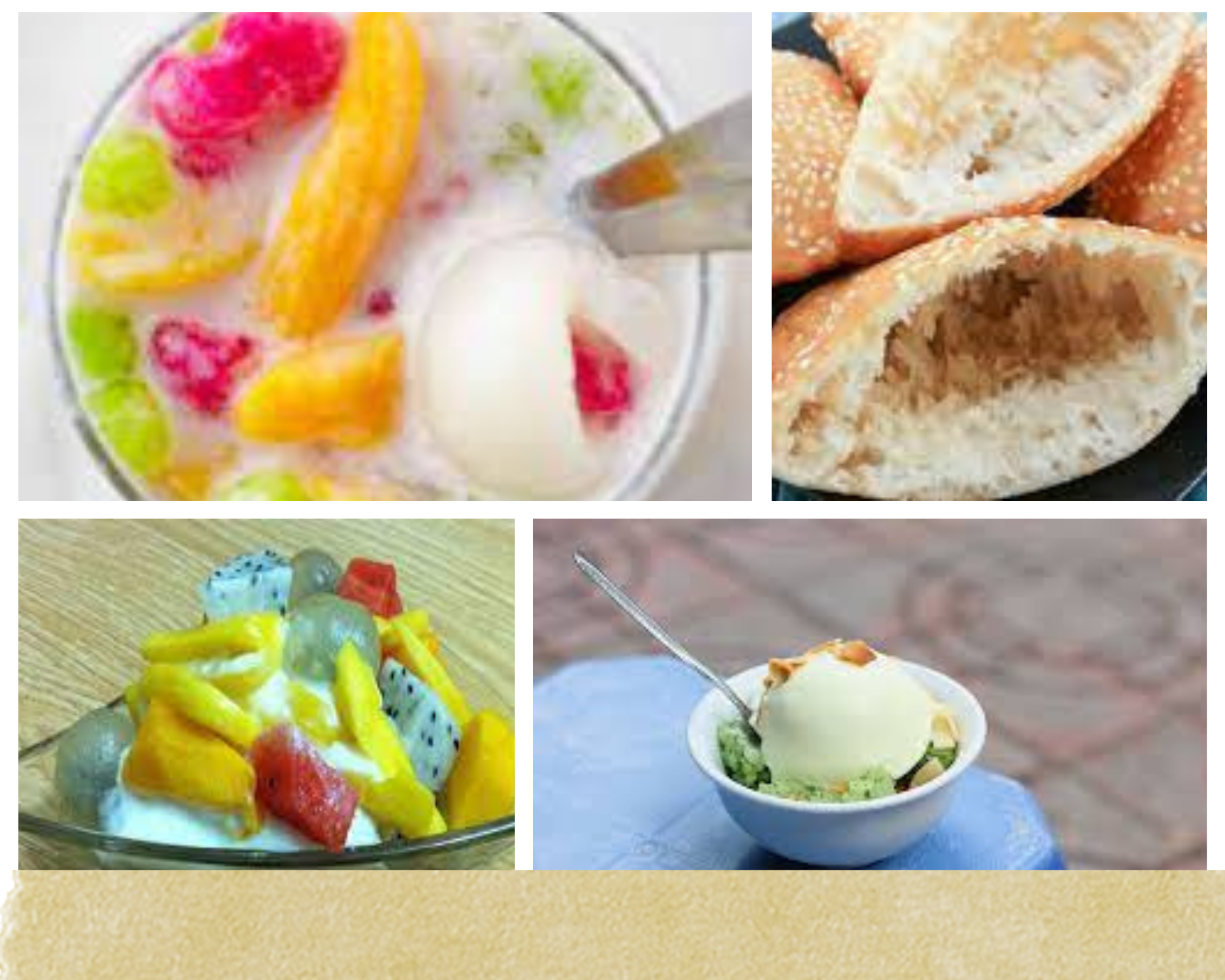
Photo Source : traveldreamdiary.com
Vietnam Restaurant Ideas
In Hanoi One of the greatest Vietnamese restaurants in Hanoi is the Hanoi Social Club. The eateries provide a distinctive selection of salads, spaghetti drinks, wraps, sandwiches, and other straightforward fare. Cau Go offers views of the lake and Vietnamese food. Vietnamese food is served at Mâm Cơm Việt Restaurant. The JW Marriott Hotel Hanoi’s Cloud Nine restaurant, French Grill, serves some of the most delicious and authentically savory cuisines, encompassing dishes from all over the world. Additionally, there is a wide variety of foreign cuisine available. Western meals and authentic dishes are available at the Essence restaurant. Among the many pho restaurants in Hanoi, Pho Gia Truyen is the most well-known, and patrons swarm there to sample the pho noodles.

Photo Source : OanaAlexandra on canva.com
In Ho Chi Minh
- Baba’s Kitchen is one of the first restaurants in the city to serve authentic Indian fare.
- NOIR – enjoying dinning in the dark? This is the perfect place for you!
- Banana Mama is reserved for afternoon and evening dining, allowing guests to enjoy the beautiful sunset views of Ho Chi Minh as they dine on a rooftop bar!
- Cyclo Resto – enjoy meals like stewed fish in a clay pot, spring rolls, egg coffee, green melon soup, and lemongrass fried chicken.
- Quince Saigon – Mediterranean dishes like: Quince’s lobster miso pasta, Israeli-spiced lamp rump, or their wood-roasted bone marrow with caviar.
- The Secret Garden Restaurant and Teahouse Rooftop – it serves sweet plates alongside their assortment of herbal teas
- Pho Phu Vuong specializes in one of the most traditional and popular Vietnamese dishes: Pho, a typical rice noodle soup.
- Bánh Mi is a street food staple of Vietnam; this softer baguette-inspired sandwich can be made with meat, cilantro, and pickled veggies.
Saving Tips
Take the overnight bus to sleep on long trips. Utilize a SIM card from a local phone. Purchase items at a discount before dining locally

Photo Source : OanaAlexandra on canva.com
Utilize Vietnam’s public transportation system to reduce your travel expenses. Get additional details from the locals. Make advance reservations for tours Verify the criteria for your Vietnam visa.
Book your tours!
Tours: If you do not go by car and need to know more information about the tours, and things to see, we recommend these companies that are offering tours for any kind of activity you want to do and where you can buy trips much cheaper than if you buy them when you arrive at your destination. It is always good to be able to save some money!
Viator, Get Your Guide, Tiqets, City Sightseeing, Sesame, Sightseeing Pass, Contiki, Riviera Travel, CityPass: the best activities in town!
Shopping
In Ho Chi Minh
Ben Thanh Market is where the greatest number of souvenir sellers set up shop during the day. Much smaller Central Market has a few dining options and souvenir vendors. Saigon Square and the Russian Market are the two markets in Ho Chi Minh City that have the biggest assortment of designer knockoffs. Forever 21 and Zara are the main brands carried by Virion 334 Cao Thang.

Photo Source : OanaAlexandra on canva.com
In Hanoi
Bat Trang Ceramic Village Metiseko: silk items Shoes on Hang Dau Street One of the greatest shopping centers is Hang Da Shopping Mall. The Hanoi Weekend Night Market features a variety of food items along with clothing, accessories, shoes, and sunglasses. Dong Xuan Market offers fresh produce, souvenirs, apparel, and accessories for electronics and home appliances. Silk Street, or Hang Gai Street
Getting Around
Buses are very popular among low-cost tourists because they are among the least expensive ways to move across Vietnam. With an enormous bus network that reaches even the most remote areas of the nation, they are also incredibly convenient. Every town has a minimum of one bus terminal. via boat and ferry One of the most delightful adventures in Vietnam is a boat tour in Ha Long Bay. Year-round, regular ferries travel to the main islands off Vietnam’s coast, such as Phu Quoc, Cat Ba, and Con Dao, weather permitting.

Photo Source : OanaAlexandra on canva.com
It is currently not possible for tourists or other transient visitors to drive themselves in Vietnam. On the other hand, renting a car, jeep, or minibus with a driver from the same businesses, organizations, and tourism offices that organize excursions is simple. Most towns and cities that receive a lot of tourists may arrange for motorbike rentals, and touring around on one can be a fun and quick way to see the sites.
Book your transport!
Rent a car!
Here you can find the best offers to rent the right car for you, as well as parking right in the airport: esky, Explorer, Centauro and intui.travel.
Getting Here
Along with extensive international flight connections to Australia, Cambodia, China, France, Germany, Hong Kong, Laos, Malaysia, Russia, Singapore, South Korea, Taiwan, Thailand, and the USA, Vietnam has several land crossings with all of its neighbors. Additionally, you can enter by train from China and by boat from Cambodia.

Photo Source : OanaAlexandra on canva.com
Vietnam is served by two major international airports: Tan Son Nhat Airport in Ho Chi Minh City and Noi Bai Airport in Hanoi. Only a tiny number of international flights are accepted by Da Nang Airport, the third airport in Da Nang.
Book tour Flights!
If you have not found your desired flight, or you simply want more flight options to find the best and cheapest, we will help you with the best flight plans, where you will definitely find what you are looking for. With just one click you will find the cheapest flights to a wonderful destination!






















